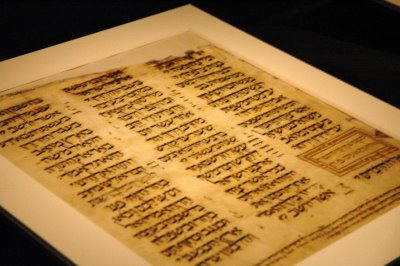Bibles Before the Year 1000 (post 2)
As Catherine and I continued our tour through this breathtaking exhibit at the Sackler Gallery, we soon came to a display containing two of the most significant early witnesses to our Hebrew Bible / Old Testament in its received, "rabbinic" form: The St. Petersburg Pentateuch and the Aleppo Codex.
Here is a photo of the St. Petersburg Pentateuch (click to enlarge):

One of our earliest, most complete Hebrew Pentateuchs, its original provenance is Palestine or Egypt, 929 ce. It may have come originally from the Cairo Genizah (see previous post). Even from my photo, you can feel the manuscript's beauty and power. The gilt-framed end-piece near the end of the right-hand column is characteristic of the manuscript. Here, it marks the end of the book of Numbers.
The display catalog lists this page as containing Numbers 35:10 through Deuteronomy 1:7, but obviously this is in error. The upper right column starts with Numbers 36:11. Here is a close up of that portion of the page:

In this image of Numbers 36:11, I've circled something near to my heart: the name of one of the daughters of Zelophehad, the biblical female-Noah, after whom Catherine and I named our cat. Did you all know there was a female Noah in the Bible??
One interesting thing you'll notice in the Hebrew that I've circled is the "closed" form of the final "h." The only way to distinguigh the ה ("h") from the similar-looking ח ("kh") is the little "tittle" extending out from the upper left of the letter. (You can see a ח in the name "Zelophehad" immediately below the "h" in "Noah."
The Allepo Codex is better known than the St. Petersburg pentateuch. It is the oldest extant manuscript known to us of the complete Hebrew Bible, and widely recognized as the finest MT witness, even finer than Codex Leningradensis, the basis for the BHS Bibles we all use in our teaching. Its provenance is Tiberias, Israel, tenth century ce.

There is a fantastic WebSite for the Aleppo Codex, not yet finished, which you simply must visit, where you can view and study the manuscript for yourself. Just click here!
2 Comments:
Beautiful photographs all around. I am sorry to have missed this exhibit. Thanks for your posts on this issue.
Thank you, Joe. I'm thinking of continuing on through more of my favorite parts of the exhibit if reader interest sustains itself. Best, ---S.
Post a Comment
<< Home